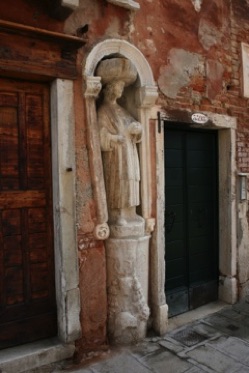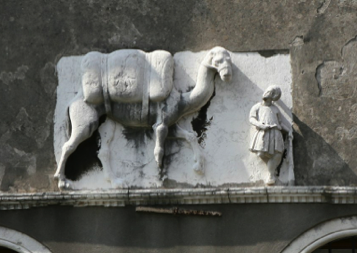Inspired by the Metropolitan Museum of Art’s exhibition “Venice and the Islamic World, 828-1797” (see July 2007 Washington Report, p.43), I recently traveled to the canal-laden city to seek out the art, in situ, influenced by the Islamic world.
Armed with the exhibit’s 300-page catalog as our guidebook, my Italian-speaking photographer husband and I wandered the streets and alleyways of La Serenissima seeking examples of Islamic-inspired art in statuary and façade decorations.
At the Scuola dei Calegheri in Campo San Toma, we viewed the brilliant 15th century marble low bas-relief, attributed to sculptor Pietro Lombardo, depicting Saint Mark healing the cobbler Anianus. According to one legend, the shoemaker converted from Islam to Christianity following this encounter.
Continuing on to the Campo dei Mori, we found the delightful 14th century bas-relief of a merchant with his camel on the façade of Palazzo Mastelli, originally home to “the Mori brothers,” as they were known locally. Across the Rio della Madonna dell’Orto and adjacent to the home of

La Serenissima’s hidden treasures revealed
Marble statue of a Mori brother on the Fondamenta dei Mori.
Tintoretto, are life-size sculptures of the Mori brothers, silk merchants involved in trade with the Levant, wearing Ottoman-style turbans and robes.
Beginning in the ninth century, Venetian merchants became regular trading partners with their counterparts in the Near East. Their many trips back and forth—and occasional extended stays in Islamic countries - influenced Venetian culture, art, architecture and fashion. The Venetians’ excellent diplomatic relations with the Ottomans and the Mamluks enabled merchants to travel extensively and as a consequence absorbed not only Islamic arts, but also customs, philosophy, science, and technology.

Merchant and camel marble bas-relief on the exterior facade of Palazzo Mastelli.
A bas-relief on the façade of the former Scuola degli Albanesi in Campo San Maurizio depicts Ottoman Sultan Mehmet II in front of the fortress of Scutari, a Venetian territory ceded to the Ottomans in a 15th century peace treaty. In 1479, at the request
of Mehmet, Venetian painter Gentile Bellini began a two-year residence in Constantinople, further enhancing the relationship between the Venetians and Ottomans.
Other exquisite Islamic-inspired treasures —hidden in plain sight—remain to be gazed upon by future intrepid travelers.

Bas-relief on the Scuola dei Calegheri in Campo San Toma of St. Mark healing Anianus.



© 2010 Phil Pasquini all rights reserved
Bas-relief of St Mark Baptizing Anianus in the Campo Giovanni e Paolo.
St. Peter’s Chair in the San Pietro in Castello church. Saint Peter used the chair while head of the diocese in Antioch. The back of the chair is composed of an Islamic head stone with engraved Koranic verses.
Mehmet II at the fortress of Scutari on the facade of the former Scuola degli Albenesi in the Campo S. Maurizio.